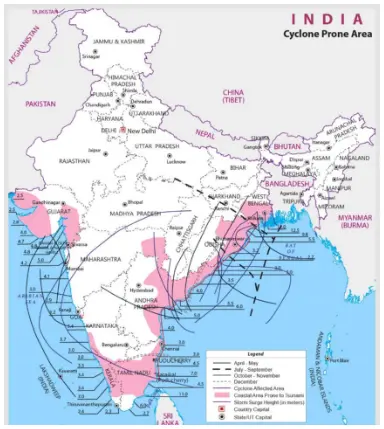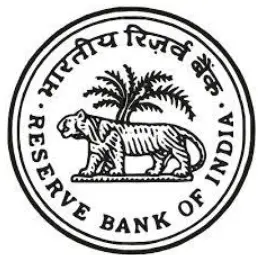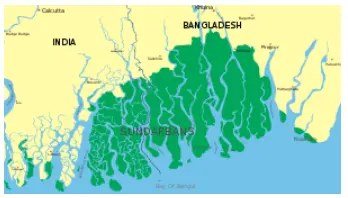Thursday, 4th April 2024
Demand for Additional Category in Tropical Cyclone Classification
In News: In a recent publication in the Proceedings of the National Academy of Sciences, researchers assert that hurricanes can reach wind speeds surpassing 309 km/hour, warranting the inclusion of a Category 6 in the wind scale.

Key Highlights of the Study
Reconsideration of Saffir-Simpson (SS) Scale
- Concerns regarding the adequacy of the Saffir-Simpson (SS) Hurricane Wind Scale, utilized for over five decades to convey hurricane risk solely based on wind speed.
- The SS scale comprises five categories, with Category 5 featuring wind speeds exceeding 252 km/hour.
- Category 5 impacts, including wind, storm surge, and rainfall, could obliterate any structure entirely.
- The existing open-ended Category 5 may no longer suffice to convey the escalating risk of hurricane damage in a warming climate.
Introduction of Hypothetical Category 6
- Global warming necessitates defining a Category 6 cyclone.
- Observations indicate warming not only at the sea surface but also in ocean depths, enhancing ocean heat content and favouring tropical cyclone intensification.
- Proposing the inclusion of a hypothetical Category 6 in the Saffir-Simpson Wind Scale with wind speeds exceeding 309 km/hour.
Impact of Global Warming on Hurricane Intensification
- Increased greenhouse gas emissions have elevated Earth's temperature by approximately 1.10 degrees Celsius since pre-industrial times, leading to more potent tropical cyclones in oceans.
- For every degree of warming, the most robust cyclones are becoming 12% stronger, rendering them 40% more destructive.
- Warmer oceans result in faster cyclone intensification and longer durations spent over the oceans, exemplified by tropical cyclone Freddy, which lasted 37 days over oceans in 2023, marking it as one of the longest-lived cyclones recorded.
Implications for Risk Messaging
- Emphasizes the necessity of revising risk messaging to effectively convey the heightened risk of major hurricanes due to global warming.
- The SS Scale overlooks inland flooding and storm surge, critical components of hurricane risk.
- Consequently, modifying messaging beyond wind-based scales is imperative to adequately communicate the full spectrum of hurricane hazards.
|
UPSC Previous Year Questions Prelims (2020) Q. Consider the following statements:
Which of the statements given above is/are correct? (a) 1 only Ans: (c) Prelims (2015) Q. In the South Atlantic and South-Eastern Pacific regions in tropical latitudes, cyclone does not originate. What is the reason? (a) Sea surface temperatures are low Ans: (b) Mains (2014) Q. Tropical cyclones are largely confined to the South China Sea, Bay of Bengal and Gulf of Mexico. Why? |
Source: TH
India's Support for the Philippines in South China Sea
In News: India's Ministry of External Affairs has firmly declared its backing for the Philippines in safeguarding its national sovereignty amid ongoing tensions with China regarding the South China Sea.

Dispute in the South China Sea Region
Significance of South China Sea
- Strategic Location: The South China Sea holds strategic importance, bordered by multiple nations including China, Taiwan, Indo-Chinese peninsula countries, Indonesia, Brunei, and the Philippines. It serves as a crucial maritime crossroads.
- Trade Importance: Approximately one-third of global shipping and over 64% of China's maritime trade pass through the South China Sea. Additionally, more than 55% of India's trade relies on this route.
- Fishing Ground: The South China Sea boasts rich fishing grounds, supporting millions of livelihoods and providing essential food security. It sustains a diverse marine ecosystem, contributing significantly to regional economies.
Dispute
- Core Dispute: The central issue revolves around conflicting claims over land features such as islands and reefs, along with the surrounding waters.
- Involved Parties: Disputes involve China, Brunei, Taiwan, the Philippines, Vietnam, and Malaysia.
- China's Claims: China's expansive "nine-dash line" claim covers up to 90% of the sea, leading to tensions as it expands islands and constructs military installations, particularly in the Paracel and Spratly Islands.
Salami Slicing Technique in Maritime Disputes
- Description: This tactic involves incremental actions by countries to assert control over maritime areas gradually. It aims to avoid direct confrontation, exploit legal ambiguities, and create irreversible situations in contested waters.
- Example: China has been accused of employing this technique in the South China Sea by building artificial islands, conducting resource exploration, and imposing fishing bans to consolidate control and restrict access for other nations.
Areas of Cooperation Between India and the Philippines
- Bilateral Trade: Bilateral trade between India and the Philippines surpassed USD 3 billion, with India exporting various goods including engineering products, pharmaceuticals, and importing electrical machinery and semiconductors.
- Health and Medicine: The Philippines granted Emergency Use Authorization for Bharat Biotech's Covaxin, contributing to about 20% of India's pharmaceutical exports to ASEAN.
- Science and Technology: Both nations signed a Programme of Cooperation in Science and Technology, focusing on areas such as agricultural biotechnology and ocean science. Additionally, India supplied a shore-based anti-ship variant of the BrahMos missile to the Philippines, showcasing India's advanced defence capabilities.
|
UPSC Previous Year Questions Prelims (2018) Q. Consider the following pairs: Regions sometimes Country mentioned in news
Which of the pairs given above are correctly matched? (a) 1, 2 and 3 Ans: c Prelims (2011) Q. Southeast Asia has captivated the attention of global community over space and time as a geostrategically significant region. Which among the following is the most convincing explanation for this global perspective? (a) It was the hot theatre during the Second World War (b) Its location between the Asian powers of China and India (c) It was the arena of superpower confrontation during the Cold War period (d) Its location between the Pacific and Indian oceans and its preeminent maritime character Ans: (d) Prelims (2018) Q. Consider the following countries:
Which of the above are among the ‘free-trade partners’ of ASEAN? (a) 1, 2, 4 and 5 Ans: c Prelims (2009) Q. Consider the following countries:
Which of the above is/are member/members of ASEAN? (a) 1 only Ans: C Mains (2016) Q. Evaluate the economic and strategic dimensions of India’s Look East Policy in the context of the post-Cold War international scenario. |
Source: IE
Internet Freedom
In News: India has consistently ranked first globally for five consecutive years in imposing internet bans, accounting for approximately 60% of all recorded blackouts worldwide between 2016 and 2022.
Key Trends of Internet Shutdowns in India
Instances of Internet Shutdown
- The Indian government enforced 780 shutdowns between January 1, 2014, and December 31, 2023. Notable spikes occurred during significant events such as protests against the Citizenship Amendment Act, the abrogation of Article 370, and the introduction of Farm Bills.
- In 2020, India accounted for over 70% of global economic losses due to internet disruptions. In 2023 alone, the country experienced shutdowns totaling over 7,000 hours.
- Jammu and Kashmir witnessed the highest number of shutdowns in the last 12 years, with 433 occurrences. The longest blackout in 2023 persisted in Manipur for seven months amid ethnic clashes.
- Between 2015 and 2022, more than 55,000 websites were blocked, with the majority censored under section 69A of the IT Act by the Ministry of Electronics and Information Technology and the Ministry of Information and Broadcasting.
Global Internet Freedom
- The latest Freedom House report highlights the deteriorating global internet freedom, with conditions worsening in 29 countries for the 13th consecutive year.
- India's ranking has declined from 59 to 50 points between 2016 and 2023, indicating a concerning trend.
Provisions Related to Internet Shutdown
- Section 5(2) of the Indian Telegraph Act, 1885, along with the Temporary Suspension of Telecom Services (Public Emergency and Public Safety) Rules, 2017, empower authorities to order internet shutdowns in case of emergencies or safety concerns.
- Section 144 of the Code of Criminal Procedure allows district magistrates to issue orders, including internet suspension, to maintain public tranquility.
Arguments Regarding Internet Shutdown
- Preventing Hate Speech and Misinformation: Shutdowns are argued to prevent the spread of hate speech and fake news, particularly during events like protests.
- Preventing Anti-National Activities: Shutdowns are viewed as a measure to curb the organization and mobilization of protests that could disrupt public order and security.
- Protecting National Security: Shutdowns are seen as necessary to protect national security and sovereignty from external threats and cyberattacks.
- Curbing Objectionable Content Consumption: Shutdowns are believed to help control the distribution and consumption of content that could be harmful or offensive.
Concerns Related to Internet Shutdown
- Violation of Rights: Shutdowns violate fundamental rights, including the freedom of speech and expression, and the right to information.
- Lack of Accountability: Shutdowns are often implemented without clear legal frameworks or oversight mechanisms, leading to arbitrary restrictions.
- Economic Disruption: Shutdowns have significant economic repercussions, disrupting online commerce, communication, and financial transactions.
- Social Disruption: Shutdowns impede communication networks, hindering access to vital services and isolating individuals from their communities.
Way Forward
- Adhering to Supreme Court guidelines on temporary and proportionate use of shutdowns.
- Strengthening legal frameworks and ensuring compliance with human rights standards.
- Considering alternative measures before resorting to shutdowns.
|
UPSC Previous Year Questions Prelims (2018) Q. Right to Privacy is protected as an intrinsic part of Right to Life and Personal Liberty. Which of the following in the Constitution of India correctly and appropriately imply the above statement? (a) Article 14 and the provisions under the 42nd Amendment to the Constitution. (b) Article 17 and the Directive Principles of State Policy in Part IV. (c) Article 21 and the freedoms guaranteed in Part III. (d) Article 24 and the provisions under the 44th Amendment to the Constitution. Ans: (c) Mains (2014) Q. What do you understand by the concept of “freedom of speech and expression”? Does it cover hate speech also? Why do the films in India stand on a slightly different plane from other forms of expression? Discuss. |
Source: TH
India TB Report 2024
In News: The India TB Report 2024, released by the Ministry of Health and Family Welfare, reveals a decline in the mortality rate attributed to Tuberculosis (TB) from 28 per lakh population in 2015 to 23 per lakh population in 2022.

Key Highlights of the Report
Trends in TB Cases and Deaths
- Reporting Sources: The majority of TB cases are reported by government health centers, although there has been an increase in notifications from the private sector.
- Private Sector Notifications: Nearly 33% or 8.4 lakh of the 25.5 lakh TB cases reported in 2023 came from the private sector, compared to only 1.9 lakh cases in 2015.
- Incidence and Mortality: The estimated incidence of TB in 2023 slightly increased to 27.8 lakh, while mortality remained at 3.2 lakh. India's TB mortality dropped from 4.94 lakhs in 2021 to 3.31 lakhs in 2022.
- Treatment Initiation: India reached its 2023 target of initiating treatment in 95% of patients diagnosed with TB.
Challenges in Meeting Targets
- Target Shortfalls: Despite setting ambitious goals, India faced challenges in meeting TB elimination targets, with the number of cases and deaths falling short of expectations.
- Contributing Risk Factors: Various risk factors, including undernourishment, HIV, diabetes, alcohol use, and smoking, contribute to TB incidence and treatment outcomes.
Initiatives to Combat TB
- Global Efforts
- WHO's "Find. Treat. All. #EndTB" initiative aims to combat TB globally, along with the Global Fund and Stop TB Partnership.
- The Global Plan to End TB, 2023-2030, provides a blueprint for ending TB as a public health challenge by 2030, adopted by all UN Member States and WHO.
- India's Efforts
- Pradhan Mantri TB Mukt Bharat Abhiyan
- National Strategic Plan (NSP) for Tuberculosis Elimination (2017-2025)
- TB Harega Desh Jeetega Campaign
- Nikshay Poshan Yojna
- RePORT India initiative, established under the Indo-US Vaccine Action Program, aims to address the threat of TB in India and globally.
|
UPSC Previous Year Questions Prelims (2017) Q. Which of the following are the objectives of ‘National Nutrition Mission’?
Select the correct answer using the code given below: (a) 1 and 2 only Ans: (a) Mains (2021) Q. “Besides being a moral imperative of a Welfare State, primary health structure is a necessary precondition for sustainable development.” Analyse. |
Source: IE
Punnett Squares
In News: Punnett squares provide a method for forecasting potential genetic outcomes in offspring resulting from the crossing of two individuals with known genotypes.

Understanding Punnett Squares: Principles and Applications
- Origin and Naming
- The Punnett Square is named after British geneticist Reginald Punnett, who developed the concept.
- Functionality
- The grid is divided into sections representing the possible genetic traits of each parent.
- By combining the traits from each parent, the squares in the grid depict potential combinations of traits for their offspring.
- This method offers a straightforward visualization of the probabilities of different traits appearing in the offspring.
- Application
- Widely utilized in biology to comprehend inheritance patterns, especially concerning dominant and recessive genes.
- It serves as a valuable tool for predicting variations and probabilities resulting from cross-breeding.
- Applicable in understanding genetic traits in offspring across various species, including humans.
- Usage with Mendelian Inheritance
- Often used in conjunction with Mendelian inheritance principles by researchers to explore genetic inheritance patterns.
Source: TH
White Rabbit Technology
In News: The European Organization for Nuclear Research, known as CERN, has recently initiated the White Rabbit Collaboration.
Introduction to White Rabbit Technology
- White Rabbit (WR) is a synchronization technology developed at CERN, in partnership with various institutes and companies, to synchronize devices in accelerators to sub-nanosecond precision, addressing the challenge of establishing a common time reference across a network.
- White Rabbit Switches offer sub-nanosecond synchronization accuracy, previously achievable only with dedicated hard-wired timing systems, while maintaining the flexibility and modularity of real-time Ethernet networks.
- The technology achieves sub-nanosecond accuracy within Ethernet-based networks and can be utilized solely for timing and synchronization purposes or for both timing and real-time data transfer.
- Initially deployed in 2012, White Rabbit's application has extended beyond particle physics into various industries.
- In 2020, it became part of the Precision Time Protocol (PTP), an IEEE standard, enhancing its global recognition and adoption.
- A notable aspect of White Rabbit is its open-source nature and adherence to standards, enabling companies and institutions to tailor it to their requirements and integrate it into their products and systems.
- White Rabbit finds applications in sectors like finance and research infrastructures, and its potential use in the future quantum internet is under evaluation.
- The technology could revolutionize global time dissemination, potentially reducing reliance on satellite-based systems.
- The White Rabbit Collaboration is a global community comprising members committed to maintaining and advancing the technology. Its goals include providing support and training, facilitating R&D collaborations, and establishing testing frameworks to ensure the reliability of products incorporating White Rabbit technology.
Source: CERN
Contempt of Court
In News: The Allahabad High Court recently stated that orders passed by the Central Administrative Tribunal (CAT) under the Contempt of Courts Act, 1971, can only be appealed to the Supreme Court and not to the High Court.
Understanding Contempt of Court
- Constitutional Provisions: Article 129 of the Constitution designates the Supreme Court as the 'Court of Record,' granting it powers to punish for contempt of itself. Article 215 similarly confers this power on High Courts.
- Types of Contempt: The Contempt of Courts Act, 1971, delineates contempt as either civil or criminal.
- Civil Contempt: Involves wilful disobedience to court judgments, decrees, orders, or breach of undertakings given to a court.
- Criminal Contempt: Encompasses acts such as publishing matter or engaging in conduct that scandalizes or lowers the authority of a court, prejudices judicial proceedings, or obstructs the administration of justice.
- Punishment: Contempt of court can lead to simple imprisonment up to six months, a fine up to two thousand rupees, or both. An apology accepted by the court may result in discharge or remittance of the punishment.
- Exceptions: Fair and accurate reporting of judicial proceedings and reasonable criticism of judicial orders post-case disposal do not amount to contempt of court.
Source: BB
Lumpy Skin Disease
In News: Indian scientists have made notable strides in comprehending the genetic composition of the virus responsible for lumpy skin disease, which has caused the demise of around 100,000 cattle since May 2022.

About Lumpy Skin Disease
- Lumpy Skin Disease (LSD) is a contagious viral infection affecting cattle.
- The disease is caused by the lumpy skin disease virus (LSDV), a member of the capripoxvirus genus within the poxviridae family.
- LSDV is not transmissible to humans, making it a non-zoonotic virus.
- Geographically, LSD is endemic in various regions including Africa, parts of the Middle East, Turkey, Balkan countries, the Caucasus, the Russian Federation, and several Asian countries.
- Transmission occurs primarily through blood-feeding insects such as flies, mosquitoes, or ticks, and through contaminated feeding and water sources.
- Symptoms of LSD include enlarged lymph nodes resulting in lumps on the skin, ulcers, scabs, fever, reduced milk yield, discharge from the eyes and nose, salivation, loss of appetite, depression, damaged hides, emaciation, infertility, abortions, and potentially death.
- Cattle are primarily affected by LSD, with buffalo being less susceptible.
- There is no direct antiviral treatment available for LSD. Supportive care involves administering antibiotics, painkillers, and wound care sprays to alleviate symptoms.
- Vaccination is employed as a preventive measure to control the spread of the disease.
Source: IT
Sea Of Japan
In News: Recently, North Korea launched a ballistic missile into the Sea of Japan, also recognized as the East Sea.

Overview of the Sea of Japan
- The Sea of Japan is a marginal sea of the western Pacific Ocean.
- It is situated in Eastern Asia and bordered by Japan and Sakhalin Island to the east, and by Russia and Korea on the Asian mainland to the west.
- Covering an area of 978,000 square kilometers, it boasts an average depth of 1,667 meters, with its deepest point reaching 3,742 meters at the Dohoku Seamount, an underwater volcano.
- Geographically, the sea lies in a deep basin, separated from the East China Sea to the south by the Tsushima and Korea straits, and from the Sea of Okhotsk to the north by the La Perouse (or Sōya) and Tatar straits.
- It is connected to the Inland Sea of Japan to the east via the Kanmon Strait, and to the Pacific Ocean through the Tsugaru Strait.
- The Sea of Japan's relatively warm waters significantly influence the climate of Japan, serving as a convergence point for cold currents from the north and warm currents from the south.
- With the exception of the South Korean Island of Ulleungdo, there are no large islands in the Sea of Japan. Most small islands are located near the eastern coast.
- Major ports in the region include Vladivostok, Sovetskaya Gavan, Nakhodka, Alexandrovsk-Sakhalinsky, and Kholmsk in Russia; Hamhung, Chongjin, and Wonsan in North Korea; and Niigata, Tsuruta, and Maizuru in Japan.
Source: NDTV
Swell Waves
In News: Coastal regions in central and southern districts of Kerala were recently submerged by swell waves.

Overview of Swell Waves
- Swell waves are the manifestation of long wavelength waves on the ocean surface, consisting of a series of surface gravity waves.
- Formation
- They originate not from local winds but from distant storms such as hurricanes or prolonged periods of intense gale winds.
- These storms transfer substantial energy from the atmosphere to the water, resulting in the formation of towering waves that can travel vast distances before reaching shore.
- Features
- Swells exhibit a narrower range of frequencies and directions compared to wind-generated waves, as they have dispersed from their source and lost some randomness, assuming a more defined shape and direction.
- Unlike wind seas, swell waves can travel in directions different from the prevailing wind direction.
- Their wavelengths typically range up to 150 meters, although exceptionally severe storms can produce swells with wavelengths exceeding 700 meters.
- Swells can emerge without warning or local wind activity.
- Early Warning Systems
- In India, the Swell Surge Forecast System, introduced by the Indian National Centre for Ocean Information Services (INCOIS) in 2020, provides forecasts up to seven days in advance, offering crucial alerts about impending swell events.
Source: TH
Katchatheevu and beyond, islands and India’s new geopolitics
In News: The review of Indian foreign policy over the past decade highlights the growing importance of island states and territories across the South Pacific to the African coast. Specifically, the Katchatheevu island stands out as a crucial focal point in India's evolving strategic landscape.
Katchatheevu Islands Overview
- The Katchatheevu Islands consist of two uninhabited islands situated in the Palk Strait, positioned between India's Tamil Nadu and Sri Lanka's northern coast.
- Historically significant due to their strategic location and their role in facilitating fishing activities for both Indian and Sri Lankan fishermen.
Fishermen Dispute
- Ownership disagreements over Katchatheevu have resulted in conflicts, especially concerning fishing rights in the surrounding waters.
- Fishermen from Tamil Nadu have been particularly affected, as they claim traditional fishing rights in the area.
- The ceding of Katchatheevu to Sri Lanka has led to restrictions on Indian fishermen accessing their traditional fishing grounds, resulting in numerous conflicts and arrests by Sri Lankan authorities.
Political and Legal Stand
- There has been criticism in India over the cession of Katchatheevu to Sri Lanka, with raised legal challenges regarding the validity of the agreements governing the island's sovereignty.
- The issue of Katchatheevu has been used politically in India to criticize the government's stance on the matter.
Bilateral Efforts
- Despite the contentious nature of the issue, both India and Sri Lanka have engaged in bilateral discussions to address the concerns of fishermen from Tamil Nadu.
- Various proposals, such as joint patrolling and fishing zones, have been suggested to resolve the issue amicably.
Evolution of India-Sri Lanka Relations
- Historically, disputes persisted until the signing of the 1974 Agreement on the Boundary in Historic Waters between India and Sri Lanka.
- The agreement guaranteed Indian fishermen access to Katchatheevu without requiring travel documents, ensuring continued fishing activities for them.
Significance for Indian Fishermen
- The agreement safeguards the fishing rights of Indian fishermen, who depend on the waters around Katchatheevu for their livelihoods.
- Access to Katchatheevu remains integral for their economic sustenance and traditional way of life.
Strategic Importance
- Katchatheevu's strategic location in the Palk Strait is crucial for monitoring maritime activities and movements in the region.
- Control over the island provides India with leverage in ensuring maritime security and safeguarding its interests.
Economic Relevance
- The waters surrounding Katchatheevu are rich in marine resources, including fish and seafood, contributing significantly to the economic well-being of fishermen from Tamil Nadu.
- Commercial activities such as fishing, aquaculture, and tourism could be further developed, boosting economic growth in the region.
Historical and Cultural Ties
- Katchatheevu holds historical and cultural significance for Tamil communities in India and Sri Lanka, with claims of traditional fishing rights dating back centuries.
- It is associated with legends and folklore, embodying the cultural heritage of the region.
Legal and Diplomatic Implications
- The issue of Katchatheevu has broader implications for India-Sri Lanka relations and raises questions about the application of international law concerning territorial sovereignty and maritime boundaries.
- It impacts India's territorial waters and Exclusive Economic Zone (EEZ) in the region, necessitating diplomatic dialogue and cooperation.
Humanitarian Considerations
- Concerns over the arrests and harassment of Indian fishermen highlight the humanitarian aspect of the issue.
- Resolving the Katchatheevu dispute is crucial from a humanitarian perspective to ensure the welfare and safety of fishermen and their families.
Security and Anti-Smuggling Operations
- Katchatheevu's proximity to the Indian coast makes it susceptible to smuggling activities, including arms, drugs, and contraband.
- Cooperation between India and Sri Lanka is essential to prevent and combat smuggling threats, ensuring regional security and stability.
|
UPSC Previous Year Questions Prelims (2009) Q. Elephant Pass, sometimes seen in the news, is mentioned in the context of the affairs of which one of the following? (a) Bangladesh Ans: (d) Mains (2013) Q2. In respect of India-Sri Lanka relations, discuss how domestic factors influence foreign policy. Mains (2022) Q3. ‘India is an age-old friend of Sri Lanka.’ Discuss India's role in the recent crisis in Sri Lanka in the light of the preceding statement. |
Source: IE
Share the article
Edukemy’s Current Affairs Quiz is published with multiple choice questions for UPSC exams
MCQ
Get Latest Updates on Offers, Event dates, and free Mentorship sessions.

Get in touch with our Expert Academic Counsellors 👋
Frequently Asked Questions
UPSC Daily Current Affairs focuses on learning current events on a daily basis. An aspirant needs to study regular and updated information about current events, news, and relevant topics that are important for UPSC aspirants. It covers national and international affairs, government policies, socio-economic issues, science and technology advancements, and more.
UPSC Daily Current Affairs provides aspirants with a concise and comprehensive overview of the latest happenings and developments across various fields. It helps aspirants stay updated with current affairs and provides them with valuable insights and analysis, which are essential for answering questions in the UPSC examinations. It enhances their knowledge, analytical skills, and ability to connect current affairs with the UPSC syllabus.
UPSC Daily Current Affairs covers a wide range of topics, including politics, economics, science and technology, environment, social issues, governance, international relations, and more. It offers news summaries, in-depth analyses, editorials, opinion pieces, and relevant study materials. It also provides practice questions and quizzes to help aspirants test their understanding of current affairs.
Edukemy's UPSC Daily Current Affairs can be accessed through:
- UPSC Daily Current Affairs can be accessed through Current Affairs tab at the top of the Main Page of Edukemy.
- Edukemy Mobile app: The Daily Current Affairs can also be access through Edukemy Mobile App.
- Social media: Follow Edukemy’s official social media accounts or pages that provide UPSC Daily Current Affairs updates, including Facebook, Twitter, or Telegram channels.






